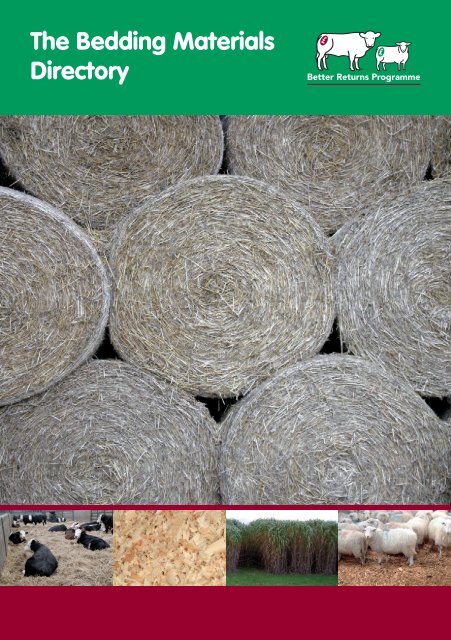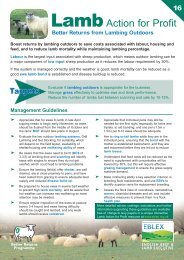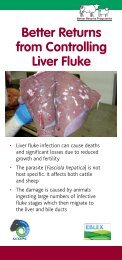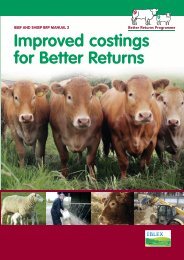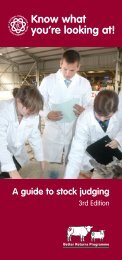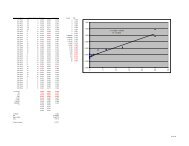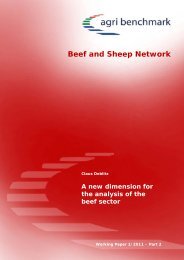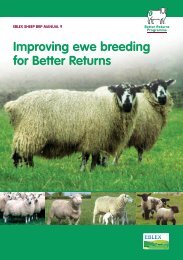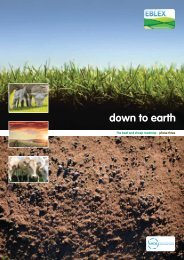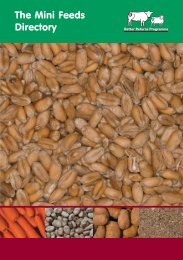Bedding materials directory - Eblex
Bedding materials directory - Eblex
Bedding materials directory - Eblex
Create successful ePaper yourself
Turn your PDF publications into a flip-book with our unique Google optimized e-Paper software.
The <strong>Bedding</strong> Materials<br />
Directory
The information in this booklet has been<br />
compiled by ADAS and Dr Mary Vickers,<br />
EBLEX Livestock Scientist.<br />
Photography: ADAS<br />
For more information contact:<br />
Better Returns Programme<br />
EBLEX<br />
Stoneleigh Park<br />
Kenilworth<br />
Warwickshire<br />
CV8 2TL<br />
Tel: 0870 241 8829<br />
Fax: 0844 774 6253<br />
Email: brp@eblex.ahdb.org.uk<br />
www.eblex.org.uk<br />
EBLEX is a division of the Agriculture and<br />
Horticulture Development Board (AHDB).<br />
©Agriculture and Horticulture Development<br />
Board 2011. All rights reserved.<br />
While the Agriculture and Horticulture<br />
Development Board, operating through its EBLEX<br />
division, seeks to ensure that the information<br />
contained within this document is accurate<br />
at the time of printing, no warranty is given<br />
in respect thereof and, to the maximum<br />
extent permitted by law, the Agriculture and<br />
Horticulture Development Board accepts no<br />
liability for loss, damage or injury howsoever<br />
caused (including that caused by negligence)<br />
or suffered directly or indirectly in relation to<br />
information and opinions contained or omitted<br />
from this document.<br />
The text of this document (this excludes, where<br />
present, any logos) may be reproduced free of<br />
charge in any format or medium providing that it<br />
is reproduced accurately and not in a misleading<br />
context.<br />
The material must be acknowledged as<br />
Agriculture and Horticulture Development Board<br />
copyright and the document title specified.<br />
Where third party material has been identified,<br />
permission from the respective copyright holder<br />
must be sought.<br />
Any enquiries regarding this document should be<br />
sent to: EBLEX division, AHDB, Stoneleigh Park,<br />
Kenilworth, Warwickshire CV8 2TL.<br />
Delivered by
Contents<br />
Page 3<br />
Cereal straw<br />
Page 4 - 5<br />
Woodchip<br />
Page 6<br />
Sawdust and<br />
wood shavings<br />
Page 7<br />
Sand<br />
Page 8 - 9<br />
Paper products<br />
Page 10<br />
Bracken<br />
1<br />
Page 10<br />
Pea haulm<br />
Page 11<br />
Rape straw<br />
Page 11<br />
Miscanthus<br />
Page 12<br />
Waste regulations<br />
Reducing bedding requirements<br />
Page 13<br />
Summary table
There is a variety of bedding <strong>materials</strong><br />
available for housed livestock.<br />
Cereal straw has been the material of choice<br />
on most beef and sheep farms in the past, but<br />
availability and cost are becoming an increasing<br />
concern in some areas of the country where less<br />
cereals are grown.<br />
Modern cereal varieties and straw shorteners have<br />
reduced straw yields, while high fertiliser prices<br />
have seen arable farmers preferring to chop and<br />
plough straw back into the soil. In some areas<br />
straw is also being sought as a biofuel.<br />
This short supply, along with high haulage costs,<br />
has forced many farmers to seek alternatives.<br />
When contemplating a new bedding<br />
material consider if it:<br />
• will keep animals dry and clean<br />
• ➢ will maintain a healthy environment<br />
for the stock<br />
• ➢ will provide a comfortable, safe bed<br />
• ➢ is readily available<br />
• ➢ is cost effective<br />
• ➢ is easy to store<br />
• ➢ will produce manure that can be<br />
applied to land<br />
• ➢ will produce manure that can be<br />
composted.<br />
2<br />
A good bedding material should be:<br />
Comfortable ✓<br />
Non-abrasive ✓<br />
Non-slippery ✓<br />
Highly absorbent of water and urine ✓<br />
Low in environmental bacteria ✓<br />
<strong>Bedding</strong> has a significant bearing on<br />
animal health and welfare. Livestock kept<br />
in badly managed housing with poor<br />
environmental conditions, will not grow<br />
well and be more susceptible to disease.
Cereal straw<br />
Straw is the most commonly used bedding material. It has good thermal<br />
properties and moderate absorption capacity which is ideal.<br />
Barley, wheat and oat straw are the most commonly used, although rye and<br />
triticale straw may be available in some areas.<br />
Barley straw £55-£65/tonne ex field Wheat straw £40-£55/tonne ex field<br />
Cost in 2011<br />
Oat straw £40-£55/tonne ex field Delivery can add £20-£40/tonne<br />
Availability Barley and wheat straw most abundant in the UK. Oat straw becoming more widely available.<br />
Good quality straw generally has a moisture content of no more than 15 - 20%.<br />
Absorbency Oat straw is the most absorbent, with wheat and barley being less so at 2.4-2.8 l/kg, 2.1 l/kg,<br />
2.0 l/kg.<br />
Quantities<br />
Benefits<br />
Deep litter bedding is preferable – topping up as needed. Barley straw is robust and lasts longer<br />
than wheat straw which is brittle and breaks down easily.<br />
Barley, wheat and oat straw are palatable, so a proportion will be eaten.<br />
Straw is still the most abundant material used. It creates a warm, comfortable bed, and can also be a<br />
palatable forage.<br />
Storage Straw should be stored under cover if possible. Wet straw has little absorptive capacity.<br />
Animal<br />
health and<br />
welfare<br />
Disposal<br />
Mould spores can produce dust which may cause respiratory problems, particularly in young<br />
animals.<br />
In wet years, the amount of mycotoxins present on the straw produced by moulds, may be<br />
high.<br />
Around 300 harmful mycotoxins have been identified. Growing wheat after maize, poor<br />
growing conditions and poor storage can increase the risk.<br />
Ruminants are considered less sensitive to mycotoxins than pigs and poultry, but intake over a<br />
prolonged period may affect reproduction and growth. In acute cases clinical symptoms<br />
include weight loss, low milk production and lowered immune status.<br />
Straw breaks down readily and can be spread on farm land after use.<br />
Analysis:<br />
Typical wheat/barley straw: Total kg/t. N 5.0 – 6.0, P 1.3 - 1.5, K 9.3 – 12.3.<br />
Typical farmyard manure (FYM) values (fresh wt). Cattle Total kg/t. N 6.0, P 3.5, K 8.0.<br />
Typical FYM values (fresh wt). Sheep Total kg/t. N 7.0, P 2.0, K 3.0<br />
Standard figures for FYM taken from: Defra, (2010). Fertiliser Manual (RB209) 8th edition.<br />
http://www.defra.gov.uk/publications/files/rb209-fertiliser-manual-110412.pdf<br />
Actual figures may vary depending on the diet fed and the dry matter of the manure.<br />
3
Woodchip<br />
Cost in 2011<br />
Availability<br />
Absorbency<br />
Woodchip can create a good free-draining bed for housed sheep and cattle on<br />
relatively dry diets, providing the woodchip is less than 30% moisture content,<br />
preferably around 20%.<br />
Research has shown that woodchip offers many animal health and welfare<br />
benefits, with limited bacterial growth and less dust than straw.<br />
Green bulk woodchips £80/tonne<br />
Recycled wood (untreated) £40/tonne<br />
Home-grown wood can be used but should be dried for six to 12 months beforehand. Most<br />
seasoned hard and soft woods work equally well for bedding.<br />
Larch is unsuitable due to its tendency to splinter. Moisture content and type of chipper used<br />
can also affect the amount of splintering.<br />
Bulk woodchip can be supplied but may be green and high in moisture requiring extra drying<br />
and space.<br />
Woodchips from virgin timber are not classed as waste, and are not therefore subject to waste<br />
controls when used as animal bedding.<br />
Virgin timber includes whole trees (or the woody parts of trees), and any off-cuts, shavings or<br />
sawdust produced from this material.<br />
Woodchips from untreated waste wood; for example packing crates and single-use pallets are<br />
classified as waste, but can be suitable for animal bedding.<br />
Untreated recycled wood is cheaper but must be screened for nails and other sharp objects.<br />
Treated timber is not permitted for bedding because of the risks to animals, the human food<br />
supply chain and problems of dealing with the soiled bedding.<br />
A waste exemption has to be registered with the Environment Agency to use waste wood<br />
as animal bedding. The appropriate exemption is U8. Further details can be found on the EA<br />
website www.environment-agency.gov.uk/business/sectors/117083.aspx<br />
The woodchip must be below 30% moisture for maximum absorbency.<br />
Larger chips drain freely allowing liquid to pass through. The bottom layer absorbs moisture<br />
well leaving the upper layers relatively dry and friable.<br />
4
Quantities<br />
Benefits<br />
There are several options for sourcing woodchip. Home-grown wood or some<br />
types of recycled wood that can be chipped on the farm, are most cost-effective.<br />
If purchased, woodchip may be more expensive than straw depending<br />
on transport costs, and total amount used. However, it can be used for<br />
several seasons.<br />
A shallow 10cm depth is preferable, applying a fresh top-up layer as required. Typically this can<br />
be every seven to ten days if animals are on a dry diet; more frequently if fed a silage-based<br />
ration.<br />
Can be re-used for many winters. Animals stay clean. There is little dust, so this is a high<br />
welfare bedding. It is readily available. Does not require spreading as the animals move it<br />
around when walking.<br />
Storage Must be stored under cover and dry. Chipped product takes up a lot of space.<br />
Animal<br />
health and<br />
welfare<br />
Disposal<br />
Animals are at least as clean as on straw, and health and welfare is equally as good.<br />
Less risk of mould development and dust, resulting in fewer respiratory problems. Untreated<br />
recycled wood may contain nails, staples or glass which may cause injury. Only buy from a<br />
reliable source.<br />
To compost the used material it has to be heaped and turned every four to six weeks. The<br />
resulting material can be sieved with any remaining coarse woodchips re-used next winter as<br />
bedding, and the compost spread on land or composted for a further two to three years.<br />
Data from the ‘Woodchip for livestock bedding project’ suggested that the nutrient level of<br />
woodchip composts was lower than straw-based composts.<br />
For more information see ‘Woodchip for Livestock <strong>Bedding</strong>’ at www.hccmpw.org.uk<br />
If using woodchips produced from virgin timber the resulting manure is not classified as waste,<br />
and can be spread on the land in accordance with Nitrate Vulnerable Zone (NVZ) rules and the<br />
Code of Good Agricultural Practice (COGAP).<br />
If using recycled woodchips a waste exemption must be registered with the Environment<br />
Agency - see page 12.<br />
5
Sawdust and wood shavings<br />
Cost in 2011<br />
Availability<br />
Absorbency<br />
Quantities<br />
Benefits<br />
Storage<br />
Animal<br />
health and<br />
welfare<br />
Disposal<br />
Sawdust can be a highly variable material depending on the source of the timber.<br />
When screened and dried, it can make good bedding.<br />
Sawdust is widely available throughout the country. Some very fine products,<br />
especially those coming from hardwood, can be dusty and may pose a risk to<br />
health. Also, fine sawdust may contaminate fleeces and is less suitable as sheep<br />
bedding.<br />
Wood shavings are used extensively in the poultry and equine industries.<br />
Kiln dried sawdust (bulk) £70 - £130/tonne<br />
Fresh sawdust (bulk) £20 - £60/tonne<br />
Recycled sawdust (bulk) £20 - £40/tonne<br />
Kiln-dried small bales (20kg) wood shavings £180 -£220/tonne<br />
Kiln-dried bulk deliveries wood shavings £125 - £140/tonne<br />
Sawdust products are widely available throughout the country. Small pre-packed bales of<br />
shavings are also sold but are much more expensive than bulk deliveries.<br />
Bulk supplies of wood shavings mixed with small wood chips are also available.<br />
Limited data from international literature suggest sawdust has absorbency of 1.5 – 2.5 l/kg and<br />
shavings 1.5 – 2.0 l/kg. Softwood products are reported to be more absorbent than hardwood.<br />
A suggested approach with sawdust bedding for cattle is to use 30 – 60 cm initially, and muck<br />
out completely every four to eight weeks. Drainage is reported to be good initially but can<br />
become very poor over time.<br />
Sawdust can be used successfully in combination with straw - alternating the two <strong>materials</strong>.<br />
Sawdust produces a comfortable, clean bed if managed carefully.<br />
It can produce a bed with a dry top layer, and is particularly useful for bedding individual<br />
animals, such as ewes in lambing pens.<br />
Sawdust should be stored under cover. However, anecdotal reports suggest that if stored<br />
outside it develops a ‘thatch’ which keeps the inside of the pile dry.<br />
Care should be taken with damp sawdust which can heat in store, increasing the risk of<br />
combustion.<br />
Sawdust from treated wood must not be used to bed livestock. Damp sawdust can also<br />
harbour moulds and has been linked to an increased risk of mastitis in dairy herds.<br />
There have also been anecdotal reports that wet sawdust bedding can increase the risk of foot<br />
problems such as scald in cattle and sheep.<br />
There is a potential health risk to humans of using very dusty sawdust, especially from<br />
hardwood.<br />
Sawdust and shavings from virgin wood are not classed as waste and the resulting manure can<br />
be spread on the land.<br />
If sourced from recycled wood refer to the waste regulation section on page 12.<br />
Woody <strong>materials</strong> such as sawdust and shavings have high carbon content and can<br />
‘lock up’ nitrogen.<br />
6
Sand<br />
Sand is a clean, dry, inert bedding material often used on dairy units in cubicles<br />
and loose housing.<br />
The nature and composition of sands can vary considerably (eg sea sand versus<br />
river or quarried sand) in particular particle size, consistency and organic content.<br />
The most appropriate sand will depend on individual circumstances.<br />
Cost in 2011 £12 - £20/tonne depending on area.<br />
Availability<br />
Widely available. Depending on location, sand may be described as animal bedding sand or sea<br />
sand.<br />
Absorbency Limited data suggests an absorbency of 0.3 l/kg.<br />
Quantities<br />
Benefits<br />
Storage<br />
Animal<br />
health and<br />
welfare<br />
Disposal<br />
In deep-bed systems farmers using sand report starting with an initial 20 – 30cm of sand and<br />
replenishing as necessary.<br />
Sand may need levelling/raking where cattle dig their feet into the beds.<br />
Produces a clean, dust-free and well-drained bed. Reported to be beneficial in dairy housing<br />
systems for reducing mastitis.<br />
No special requirements as sand is readily available throughout the year. Additional quantities<br />
can be purchased as necessary reducing the need for extensive storage facilities.<br />
Reported to be beneficial when used in cubicles for dairy cattle, although fine washed sand is<br />
recommended as coarser material can be too abrasive. Not generally recommended for use at<br />
calving as it sticks to the new-born calf.<br />
Sand is an abrasive substance and can accelerate wear in slurry/muck handling equipment and<br />
on concrete surfaces.<br />
The resulting manure can be spread on the land. Depending on the type of sand used, the<br />
resulting manure may have a liming effect. Cornish sea ‘shell’ sand has a neutralising value of<br />
30 - 40%, although the material is slower acting than ground limestone.<br />
Sand may also act as a soil improver if spread on heavy land.<br />
7
Paper products<br />
Paper makes highly absorbent bedding with a moisture content of approximately 10%. It is not dense and<br />
is easily displaced by heavy animals, and unless shredded into small pieces, tends to leave bare patches of<br />
floor.<br />
It is difficult to obtain directly from paper mills but can be bought ready-prepared by bedding companies<br />
at a higher cost.<br />
Waste shredded paper and cardboard, dried paper sludges and plasterboard backing paper, can all be used<br />
for animal bedding. As these are considered wastes, a waste exemption must be registered before using<br />
them – see page 12.<br />
A new product is expected to come to market in 2011, providing a blend of paper crumb and lime ash that<br />
can be used as a complete bedding material, or in conjunction with straw.<br />
Paper crumb<br />
Paper crumb is a by-product from the paper<br />
industry whereby short fibres are removed to<br />
produce a sludge-like material which is then rolled<br />
to remove excess moisture at source.<br />
Typically the moisture content is around 50%, but<br />
it can be kiln dried to reduce the moisture content<br />
to less than 10%. Whilst this process significantly<br />
increases the moisture absorbency of the product<br />
the cost also rises.<br />
8<br />
Lime ash (paper sludge ash)<br />
Lime ash is produced from paper sludge, which is<br />
the short fibres which are washed out when paper<br />
is recycled. The slurry contains lime, which is a<br />
filler and whitener used in the previous papermaking<br />
processes. This is burnt, filtered and 15%<br />
water added to produce a product that resembles<br />
a sand-like material.<br />
It has been sold for the past four to five years<br />
throughout the UK as a bedding desiccant. Lime<br />
ash should not be used as a bedding by itself. As it<br />
has a high pH it must be used with other bedding<br />
<strong>materials</strong> to prevent animals from being burnt.<br />
To date over 300,000 tonnes have been used<br />
by livestock farmers throughout the country –<br />
mainly in the dairy sector as it can help prevent<br />
mastitis. It can also be applied to beef and sheep<br />
housing if mixed with straw, shavings or sand.<br />
A waste protocol relating to the production<br />
and use of paper sludge ash is currently being<br />
researched and developed. More details at:<br />
http://www.environment-agency.gov.uk/<br />
business/topics/waste/114433.aspx
Cost in 2011<br />
Availability<br />
Absorbency<br />
Quantities<br />
Benefits<br />
Storage<br />
Animal<br />
health and<br />
welfare<br />
Disposal<br />
Prepared bedding at 10% moisture content £70 - £95/tonne<br />
Crumb from source at 50% moisture content £10 - £15/tonne<br />
Paper crumb/lime ash mix £27 - £40/tonne<br />
Lime ash (depending on area) £20/tonne<br />
Shredded paper direct from source is difficult to find. Prepared paper bedding products are widely<br />
available but incur a higher cost. Paper crumb from source is available in most areas of the UK<br />
with the price dependant on haulage costs. Lime ash is readily available throughout the UK.<br />
Highly absorbent if kiln dried to below 10% moisture content. The raw product is significantly less<br />
absorptive.<br />
Lime ash is highly absorptive and needs moisture adding to prevent bedding sticking to the animals.<br />
Prepared paper bedding – beef and sheep require a 10cm depth at the start of the winter. Cows<br />
need 200kg per cow per winter, costing approximately £14 - £19/cow. It can also be used under<br />
straw at a depth of around 5 -10cm which reduces straw requirement by up to 25%.<br />
Raw paper crumb can be used at a similar depth but may need replenishing more frequently.<br />
Lime ash can be added at a similar depth to paper crumb but must be mixed with another material.<br />
Prepared kiln dried bedding has high absorbency, good thermal properties, is comfortable, produces<br />
little dust and degrades quickly. It also tends to have low spore and pathogen levels.<br />
Raw crumb is less absorbent but much cheaper as a bedding source so can be used more liberally.<br />
Lime ash is readily available and cheap. It can be stored outside. High pH reduces pathogen loading.<br />
Dried paper products must be stored under cover in dry conditions.<br />
Lime ash can be stored outside but must be on a free-draining surface. It appears to form a<br />
surface crust which rain can run off leaving the inside of the heap dry.<br />
When stored under cover, moisture content levels continue to drop and the material can<br />
become very dusty, making it more difficult to handle.<br />
Prepared bedding may help reduce/control pathogen levels. Animals are kept warm and clean<br />
and low dust levels reduce respiratory problems.<br />
Raw paper crumb has had no adverse effects on livestock health or welfare on the many farms<br />
that are using it, although no clinical trials have been performed.<br />
Lime ash is highly alkaline and used on its own may cause teat scalding. It should not be used<br />
without a top layer of straw or other material for calves or lambs, as the powder ‘cakes’ on<br />
their skin and the high pH can scald their noses.<br />
Can clump together making spreading or composting difficult. If clumps can be broken down<br />
effective composting and spreading can be achieved.<br />
Lime ash is non-organic and does not degrade when composted. It can be spread on fields but<br />
because of its alkaline nature test soil beforehand to check pH.<br />
Analysis: Paper crumb at 40% DM has N 2.0, P 0.4, K 0.2 total kg/tonne.<br />
If composted, paper crumb requires an exemption to be registered under T23 –<br />
see http://www.environment-agency.gov.uk/business/sectors/117109.aspx<br />
and an exemption to spread under U10 - see http://www.environment-agency.gov.uk/<br />
business/sectors/117085.aspx<br />
9
Bracken and Pea haulm<br />
Cost in 2011<br />
Bracken<br />
Bracken has been used as livestock bedding for centuries. Harvesting the fronds in late<br />
summer/autumn when die-back starts naturally is considered to produce the highest<br />
yield and most easily dried crop. Bracken spores are known to have carcinogenic<br />
properties and the material should be handled with care.<br />
Costs usually consist of on-farm cutting, baling and transportation. Bracken is not typically<br />
sold off-farm.<br />
Availability Readily available in certain geographical areas. Harvesting may be difficult on some terrain.<br />
Absorbency<br />
It is suggested that bracken is at least as absorbent as cereal straw with a moisture content of<br />
around 20%<br />
Quantities Quantities used are similar to conventional straw<br />
Benefits<br />
Freely available in certain areas and can be harvested using conventional machinery. Creates a<br />
comfortable and durable bed. Can be stored easily.<br />
Storage No specific storage requirements - similar to conventional straw bale<br />
Animal<br />
health and<br />
welfare<br />
Disposal<br />
Studies suggest bracken may cause bladder lesions or carcinomas in cattle and can lead to<br />
blindness in sheep. It is also thought to cause haemorrhages, with cattle more susceptible.<br />
The toxicity of bracken varies with plant growth stage, being highest in young leafy material<br />
and lowest at the optimum cutting stage in the autumn.<br />
The evidence suggests that bracken should be avoided if possible due to the animal health<br />
problems identified on farms that have used bracken as bedding a lot in the past.<br />
Bracken breaks down more readily than straw so can be spread on land and used as fertiliser.<br />
Analysis: Composted bracken bedding: Total kg/t. N 3.86, P 1.5, K 8. 1.<br />
Pea haulm<br />
Pea straw is often used as a feeding forage due to its high protein content. It tends to be<br />
brittle, breaking up easily and making it difficult to bale. It is reported to make poor<br />
bedding as it is not very absorbent.<br />
Cost in 2011 £60/tonne plus delivery costs<br />
Availability<br />
10<br />
1 Data from IGER leaflet 605.01 ‘Why compost farmyard manure’ 2007<br />
Available from larger straw merchants. However only small amounts are grown in certain<br />
regions so not generally available in large quantities<br />
Absorbency Reputed to have poor absorbency, however, no definitive figures are available.<br />
Quantities<br />
Pea straw should be used initially in the same quantity as other cereal straws. However, it may<br />
need replenishing more frequently due to being so brittle.<br />
Benefits Can be used as forage.<br />
Storage Must be stored undercover as it starts to degrade rapidly when damp.<br />
Animal<br />
health and<br />
welfare<br />
Disposal<br />
Reputed to have poor absorbency so animals become dirty quite quickly.<br />
Pea straw breaks down readily and the resulting manure can be spread on land.<br />
Analysis: Pea straw (fresh wt): Total kg/t. N 1.2, P 3.9, K 20.0.
Rape straw and Miscanthus<br />
Rape straw<br />
Oilseed rape straw is readily available and has a high oil content so in demand as a biofuel.<br />
It has a stalky structure and is best used as a bottom layer with cereal straw on top.<br />
Cost in 2011 £40/ tonne ex field.<br />
Availability Readily available in some (arable) areas.<br />
Absorbency<br />
Quantities<br />
There are no figures available on absorbency but it appears to be free draining more than<br />
absorbent.<br />
It is suggested that putting around 50 – 60 cm of rape straw in the base of a bed with cereal<br />
straw on top, can reduce straw requirement by up to 30%.<br />
Benefits A cheap free-draining bedding material which is readily available in some areas of the UK.<br />
Storage<br />
Animal<br />
health and<br />
welfare<br />
Disposal<br />
Similar to cereal straw. However, some reports suggest that round rape straw bales need<br />
handling carefully as they are less robust. Round bales have also been reported to be difficult<br />
to roll out.<br />
Rape straw should be dried to below 20% moisture content to prevent moulds spoiling the<br />
product and causing animal health issues. This may prove difficult in UK conditions.<br />
Rape straw is very stalky and may not be suitable for young lambs or calves.<br />
Breaks down readily and the resulting manure can be spread.<br />
Analysis: Rape straw (fresh wt): (Total kg/t) N 7.0, P 2.2, K 11.5. 2.<br />
2 Ref: National and regional supply/demand balance for agricultural straw in Great Britain – report prepared for the National Non-Food Crops Centre)<br />
Cost in 2011<br />
Availability<br />
£200/tonne for small quantities of prepared pre-packed bales. Large bales of miscanthus at<br />
20% moisture content, may be available in some areas at £40 - £50/tonne.<br />
Prepared bedding is available nationally. However, large dried bales may only be available in<br />
certain areas.<br />
Absorbency Miscanthus is stated to be highly absorbent once dried to below 25% moisture content.<br />
Quantities<br />
Benefits<br />
A good depth of 30 – 50 cm initially, topped up with fresh bedding as needed.<br />
The bed initially is not very dense and is easily displaced by stock leading to bare patches.<br />
Practical experience suggests adding a small amount of moisture helps prevent this.<br />
Highly absorbent. Creates a comfortable bed with good thermal properties. Animals remain<br />
clean and warm.<br />
Storage No special requirements but must be kept dry.<br />
Animal<br />
health and<br />
welfare<br />
Disposal<br />
Miscanthus<br />
Miscanthus or elephant grass is a perennial grass usually grown as a biomass crop.<br />
It is tall and stalky and when harvested, has a high moisture content. It must be chopped and<br />
dried before use. Used increasingly in the equine and poultry industries, bedding companies<br />
chop the straw, dry it, and sell it in pre-packed, small bales.<br />
Miscanthus straw bought from a bedding merchant is free of dust and mycotoxins. However,<br />
farmers may struggle to dry the product sufficiently to stop moulds forming.<br />
The resulting manure degrades quickly and can be spread onto land.<br />
11
Waste regulations<br />
Some alternative <strong>materials</strong> require a waste<br />
exemption to be registered with the Environment<br />
Agency before they can be used as animal bedding.<br />
The appropriate exemption is U8; further details<br />
can be found on the Environment Agency website<br />
www.environment-agency.gov.uk/business/<br />
sectors/117083.aspx<br />
The relevant agricultural waste exemptions are<br />
free of charge and can be registered online or on a<br />
paper form:<br />
www.environment-agency.gov.uk/business/<br />
topics/permitting/116406.aspx<br />
Contact the Environment Agency customer service<br />
centre on 03708 506506 for further guidance and<br />
copies of the relevant forms.<br />
The Environment Agency has a position statement<br />
that allows for the composting or anaerobic<br />
digestion of soiled bedding <strong>materials</strong> that have<br />
Reducing bedding requirements<br />
• Extend grazing period or consider<br />
out-wintering<br />
• Store bedding in a dry place –<br />
preferably in buildings or under heavyduty<br />
sheeting<br />
• Ensure any water from gutters or<br />
water troughs cannot enter the<br />
bedded area<br />
• Consider having a scraped (concrete)<br />
feed area which is cleaned out a few<br />
times a week. This can reduce the<br />
amount of bedding needed<br />
12<br />
been used in accordance with U8 exemption:<br />
www.environment-agency.gov.uk/static/<br />
documents/Business/MWRP_RPS_077_<br />
Composting_bedding_material_v2_Mar_11.pdf<br />
Re-registration<br />
Farmers who registered an exemption to use waste<br />
such as woodchips or paper as animal bedding<br />
before 6th April 2010, would have registered a<br />
paragraph 15 exemption with a paragraph 12<br />
exemption to compost it, and a paragraph 7 to<br />
spread it.<br />
They will need to re-register in the new exemption<br />
system by 1st October 2013. Further information<br />
about these changes can be found on the<br />
Environment Agency website:<br />
www.environment-agency.gov.uk/<br />
agriculturalwaste<br />
considerably as up to 40% of cattle<br />
waste is excreted whilst feeding<br />
• Site water troughs on the scraped area<br />
• Ensure buildings are well ventilated<br />
to eliminate moist air and help keep<br />
bedding dry<br />
• Ration type can have a big effect.<br />
Requirements are higher for animals<br />
on silage-based diets than those on<br />
concentrate or straw-based diets.<br />
Excessive salt intake can also cause<br />
animals to drink more and increase<br />
bedding requirements.<br />
For more information on out-wintering on woodchip pads – visit www.eblex.org.uk and<br />
download BRP Plus+ document: Improved design and management of woodchip pads for<br />
sustainable out-wintering of livestock.
Summary table<br />
The list of bedding <strong>materials</strong> described in this<br />
booklet is not exhaustive and other <strong>materials</strong><br />
may be available.<br />
Many of the alternative bedding <strong>materials</strong><br />
discussed here work well when combined with<br />
traditional cereal straws, either forming a freedraining<br />
base layer underneath straw, for example<br />
rape straw, or mixed with cereal straw such as<br />
paper or sawdust.<br />
It is important to ensure that any bedding<br />
material has been screened to remove<br />
contaminants such as nails, metals, glass and<br />
13<br />
plastic that could cause injury.<br />
Products that must not be used for livestock<br />
bedding include:<br />
• Poultry litter. Animal by-product regulations<br />
prevent the use of this because of disease risk<br />
such as Salmonella<br />
• Re-cycled rubber. It is illegal to spread this on<br />
the land as a fertiliser<br />
• Woodchip produced from treated timber. This<br />
poses risks to animals, may impact on food<br />
chain safety and cause disposal problems.<br />
Cost per tonne Availability Absorbency Benefits Animal Health Disposal<br />
Straw £40 - £65 Widely Moderate Abundant Mould spores<br />
Woodchip<br />
£40 - £80 to<br />
purchase<br />
Widely Low Abundant<br />
Sawdust £20 - £130 Widely Moderate Abundant<br />
Wood shavings £120 - £220 Widely Moderate<br />
Sand<br />
£12 - £20 to<br />
purchase<br />
Paper products £10 - £70 Widely<br />
Bracken<br />
On-farm<br />
harvesting<br />
Widely Low<br />
Low to high<br />
depending<br />
on product<br />
Clean, can be<br />
dust free<br />
Hygienic<br />
bedding<br />
material for<br />
cubicles<br />
Liming effect,<br />
abundant<br />
Cheap<br />
depending on<br />
product sourced<br />
Niche Moderate Cheap, warm<br />
Pea haulm £60 Limited Low<br />
Oilseed rape<br />
straw<br />
Miscanthus<br />
Prepared<br />
bedding<br />
Bales ex field<br />
Palatable -<br />
forage<br />
£40 Limited Low Clean, dust free<br />
Up to £200<br />
£40 - £50<br />
ex field<br />
Prepared bedding<br />
– limited<br />
Large bales not<br />
widely available in<br />
all areas<br />
High Clean, dust free<br />
High yielding<br />
crop<br />
Must be below<br />
30% moisture<br />
content<br />
Mould spores in<br />
damp sawdust.<br />
Can be dusty<br />
None if kiln<br />
dried and dust<br />
extracted<br />
Coarse sand may<br />
be too abrasive<br />
May cause teat<br />
scald using lime<br />
ash<br />
Potentially<br />
carcinogenic<br />
Animals become<br />
wet and dirty<br />
quickly<br />
Very stalky<br />
material<br />
None<br />
Moulds if not<br />
dried correctly<br />
Rots down and<br />
spreads easily<br />
Can be composted<br />
and reused in<br />
subsequent years or<br />
spread on the land<br />
Easily spread to land.<br />
Can ‘lock up’ nitrogen<br />
Easily spread to land.<br />
Can ‘lock up’ nitrogen<br />
Causes excessive<br />
wear on slurry/muck<br />
handling equipment<br />
and can settle out in<br />
slurry systems<br />
May clump and cause<br />
difficulty spreading,<br />
may increase nitrogen<br />
requirement<br />
Rots down and<br />
spreads easily<br />
Rots down and<br />
spreads easily<br />
Rots down and<br />
spreads easily<br />
Rots down and<br />
spreads easily
Other BRP publications available<br />
Beef BRP<br />
Manual 1 – Choosing Bulls to Breed for Better Returns<br />
Manual 2 – Beef Selection and Handling for Better Returns<br />
Manual 3 – Improving Cattle Handling for Better Returns<br />
Manual 4 – Beef Production from the Dairy Herd<br />
Manual 5 – Feeding the Suckler Cow<br />
Manual 6 – Improved Beef Housing for Better Returns<br />
Manual 7 – Feeding Growing and Finishing Cattle for Better Returns<br />
Manual 8 – Optimising Suckler Herd Fertility for Better Returns<br />
Manual 9 – Controlling Worms and Liver Fluke in Cattle for Better Returns<br />
Sheep BRP<br />
Manual 1 – Target Lamb Selection for Better Returns<br />
Manual 2 – Target Ram Selection for Better Returns<br />
Manual 3 – Target Lamb Management for Better Returns<br />
Manual 4 – Target Ewe Management for Better Returns<br />
Manual 5 – Target Store Lamb Management for Better Returns<br />
Manual 6 – Target Easier Management for Better Returns<br />
Manual 7 – Target Lameness for Better Returns<br />
Manual 8 – Target Worm Control for Better Returns<br />
Manual 9 – Improving Ewe Breeding for Better Returns<br />
Manual 10 – Controlling External Parasites for Better Returns<br />
Manual 11 – Target Ewe Fertility for Better Returns<br />
Manual 12 – Improving Ewe Nutrition for Better Returns<br />
Manual 13 – Improving Sheep Handling for Better Returns<br />
Joint Beef and Sheep BRP<br />
Manual 1 – Improving Pasture for Better Returns<br />
Manual 2 – Improved Costings for Better Returns<br />
Manual 3 – Improving Soils for Better Returns<br />
Manual 4 – Managing Clover for Better Returns<br />
Manual 5 – Making Grass Silage for Better Returns<br />
Manual 6 – Using Brassicas for Better Returns<br />
© Agriculture and Horticulture Development Board 2011.<br />
All rights reserved.<br />
The tables and contents of this publication may not be<br />
reproduced without the express permission of EBLEX<br />
For more information contact:<br />
Better Returns Programme<br />
EBLEX<br />
Stoneleigh Park, Kenilworth<br />
Warwickshire CV8 2TL<br />
Tel: 0870 241 8829<br />
Fax: 0844 774 6253<br />
Email: brp@eblex.ahdb.org.uk<br />
www.eblex.org.uk


